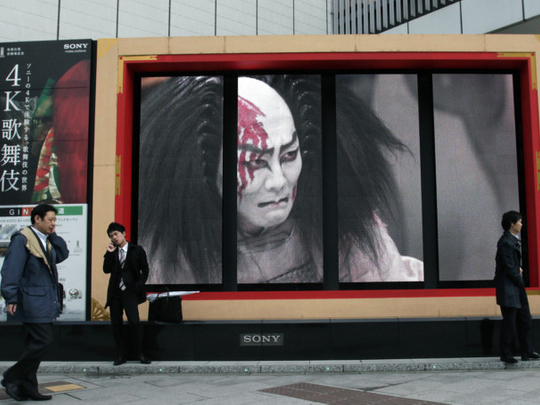
While it is too early to do a Japanese version of the Harlem Shake, the clouds of doom and gloom might be thinning for some of Japan’s largest consumer electronics firms. On the back of the Bank of Japan’s Governor Haruhiko Kuroda’s announcement of strong measures to fight deflation and double the money floating in the financial system, the yen fell to its lowest against the dollar since June 2009. This is bound to ease exports and make it cheaper worldwide to buy Japanese electronics.
That, in fact, has been one of the biggest drawbacks with devices churned out by Japanese firms — they are not cheap enough to compete with goods coming out of China and Korea. And, in some key areas, neither are they technologically superior — thanks to the two lost decades (1991-2010) when, from being on the cutting edge of technology, Japanese firms buckled down and cut back on research and development. Meanwhile, their competitors invested heavily in innovation and surged ahead.
But times have changed, and Japan’s mighty consumer electronics brands are now game for a drastic rethink in strategy. Sony has resorted to selling off office space to raise capital, Panasonic has announced it is getting out of the plasma display market, while Sharp is busy wooing foreign investors. Epson is among the few Japanese conglomerates to expand, buoying its presence in the Middle East by opening its first office in Saudi Arabia earlier this month. As of now, lay-offs, once unheard of in Japan, are the new normal.
Desperate times, bailouts
In fact, the recent melodrama at Sharp is worthy of a television soap opera — the very enemy that had snatched market share from Sharp and pushed the iconic brand to the brink of disaster is now pumping in money and will become Sharp’s fifth-largest shareholder. Some bloggers went as far as calling it a “betrayal of Japan” and a sell-out. Indeed, a few years back, it would have been unthinkable that a proud company such as Sharp Corporation would accept 10.3 billion yen (about Dh384 million), in exchange for a 3 per cent stake from its former arch-nemesis, South Korea’s Samsung Electronics.
But desperate times call for desperate bailouts. The big Japanese firms had invested heavily in flat-panel displays, a market that crashed spectacularly. According to the Japan Electronics and Information Technology Industries Association, 25.19 million flat-panel TVs were shipped to the domestic market in 2010. In 2012, that tumbled to 6.45 million units. But there are signs that some of the dazzle will return next year onwards — the government is injecting fresh demand for flat panels by launching the world’s first ultra high-definition broadcast in July 2014, a full two years ahead of schedule. This should help the majors sell expensive, and high-margin, 4K TVs in the domestic market.
However, while TV sales are tanking, smartphone and app sales are soaring to new giddy heights. Japan-based market research firm Central Research Services Inc estimates that smartphone usage in Japan doubled in the last year — up from 19.5 per cent to 35.4 per cent.
And, according to App Annie, a research firm specialising in mobile apps, Japan has overtaken the US and now brings in the largest revenue on Google Play, the app store for Android smartphones. The firm also estimates Apple’s iOS revenues at four times that of Google Play. Not surprising, given that Apple sold the most phones in Japan in 2012, edging out strong local rivals such as Sharp and Fujitsu. Hong Kong’s Counterpoint Research estimates a 15 per cent market share for Apple.
Timely development
This mobile explosion has been welcome news for mobile game developers. The largest revenue earner, worldwide on iOS is not an American company — rather it is Japan’s GungHo Online with its roster of 14 games. The company’s market cap at $3.3 billion (about Dh12 billion) is larger than Zynga, while its Puzzles and Dragons has been a top monetising game on iOS and Android platforms globally.
At the other end of the gaming spectrum, Sony is expecting to reap in another windfall. 2013 is a key year, as it launches the PlayStation 4. The first three iterations of the gaming console sold more than 300 million units, and hopes are high that hardcore gamers will rush out to buy the PS4, oblivious of the mobile gaming revolution sweeping around them. Sony is on a stronger footing here unlike Nintendo, which finds its casual gaming business under fire as gamers migrate to tablets and phones.
Mobile segment sales rise
Another key market shaken up by the mobile tsunami is the traditional Japanese bastion — cameras. According to Japan’s Camera and Imaging Products Association, venerable brands such as Canon, Nikon and Olympus saw global sales tank by 42 per cent to 7.58 million units in September 2012, as compared to the previous year. Elsewhere, Canon Inc has already forecasted that it will sell 17 million compact cameras this year versus the 18.3 million sold in 2012.
Fittingly, another mobile segment, the car entertainment market, continues to be on a smooth profit highway. According to a research titled In-Car Entertainment (Infotainment) Market by MarketsandMarkets, this niche is expected to bring in $14.4 billion by 2016. Great news for Japanese brands such as Pioneer, Clarion and Alpine, which already dominate this market.




